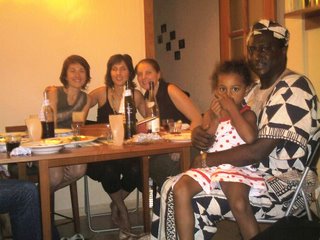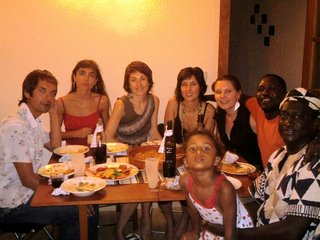Letzte Woche Freitag gab es mal wieder Thieboudienne und Bisaap! Und alle fanden es sehr lecker. Sidi hatte sich diesmal Unterstützung von Makha zum Kochen geholt...
 Yan (China), ihr Mann David (Spanien), Bea - Makhas Frau (Spanien)
Yan (China), ihr Mann David (Spanien), Bea - Makhas Frau (Spanien)
 Elvira (Kasachstan), Lucie (Frankreich), Schneggi, Makha (Senegal), seine Tochter Diarra
Elvira (Kasachstan), Lucie (Frankreich), Schneggi, Makha (Senegal), seine Tochter Diarra
 Unsere erste Zimmerpflanze!! - ein Geschenk von Lucie
Unsere erste Zimmerpflanze!! - ein Geschenk von Lucie

"... flying to Senegal from New York, some visitors get their first glimpse of West Africa even before the coastline comes into view. Still miles from the port of Dakar, Senegal's capital city, the careful observer can spot wooden fishing canoes in bright primary colors bobbing like toys in the Atlantic waves far below. Each day, fishermen of the Lebou ethnic group set out from all along the coast around Dakar in search of ciof (pronounced choff), a meaty white species of grouper prized by Senegalese.
The ciof is the centerpiece of Senegal's national dish, a savory array of vegetables and grouper steaks stuffed with herbs and served over rice, called ceeb u jen (pronounced CHEB-oo-JEN). The phrase means ''rice with fish'' in Wolof, the most widely spoken African language in Senegal, where the official language is French. To bring tears to the eyes of a homesick Senegalese street merchant in New York, all you need to do is call up the memory of his mother's ceeb u jen.
The preparation of ceeb u jen is a labor of love performed by countless Senegalese wives and mothers each morning, involving over a dozen ingredients and several hours of cooking. The Senegalese workday seems to be scheduled around ceeb at noon, with a long break that allows workers to go home, eat with the family and indulge in a nap induced by a meal that could never be described as light.
Ceeb u jen originated in the northern Senegalese city of St. Louis, the former colonial capital of French West Africa, at around the turn of the century. Prof. Abdou Khadre Beye, in his book ''Study of the Traditional Culinary Art of the Senegambia,'' asserts that the dish was promoted by the French to increase demand for the colonial cash crop, peanuts. ''They went so far as to impose a national recipe . . . with the simple goal of selling peanut oil,'' he writes. Lately, ceeb u jen has also come under attack for its use of unhealthy amounts of oil and for its dependence on imported rice, for which Senegal spends about $139 million each year.
Yet this culinary nationalism has altogether failed to curb the massive consumption of ceeb u jen. In fact, as people continue to migrate to Dakar from the countryside and settle into sprawling suburbs, a new phenomenon has arisen: in response to the growing number of city workers who live too far from the center of town to go home for lunch, hundreds of women have started businesses selling the dish out of their homes at noon. These gargotes, as they are known in French, or ''ceeb joints'' are usually unmarked courtyards where you can sit on a simple wooden bench and eat ceeb out of a plastic bowl for as little as 75 cents.
Lika Sarre - a woman of impressive proportions, always dressed in a flowing, full-length boubou and matching headwrap - presides over one of the most highly acclaimed ceeb joints in Dakar. ''I make ceeb u jen here as if I'm making it for my own family,'' she says. After bearing eight children, Mrs. Sarre decided 10 years ago that she could supplement her family's income by preparing 30 extra meals a day and serving them at little tables in her garden courtyard. Each day she prepares two Senegalese dishes, one of which is always ceeb. ''I have some clients who won't eat the other dish, even if the ceeb u jen is all gone,'' says Mrs. Sarre. ''It's tradition.''
At dawn each morning, a large gray parrot in the courtyard begins squawking and awakens the Sarre household. Mrs. Sarre seats herself on a bench in the middle of the courtyard, spreads her boubou around her and begins to direct the proceedings of her two full-time assistants. The first step in preparing the dish is to make the roof (pronounced roff), the piquant stuffing tucked into little pockets in the fish. With a large wooden mortar and pestle, parsley, garlic, scallions, hot peppers, salt, black peppercorns and bouillon cubes are pounded into a paste.
Next, the fish is cut into thick steaks and the roof is inserted into slits in the sides of the steaks with the tip of a knife. Meanwhile, the vegetables are rinsed in a large calabash filled with water. They vary with the season but often include carrots, cabbage, eggplant, turnips, okra, squash, manioc and jakatou - a vegetable that resembles a small green tomato but is actually a member of the eggplant family. The jakatou has a bitter taste that aficionados crave and others abhor. Senegalese will tell you, with a wink, that someone who doesn't eat the jakatou may be a demm, a genie of local folklore said to eat human souls.
The fish and vegetables are stewed in a huge iron caldron set atop a wood-burning brazier in the courtyard, in a sauce with a base of onions, peanut oil and tomato paste. The rich and complex flavor of ceeb u jen depends on a wide variety of ingredients, some of them unfamiliar to Western palates, that are added to the sauce. The most unusual ingredient is a huge chunk of flesh from a dried shellfish known as yeet, found in the coastal waters off Senegal. The elegant, curled orange shell of the yeet is used as an ashtray in many Dakar homes.
Another essential ingredient is gejj, or dried fish. Mrs. Sarre wraps the gejj in leaves of the guinea sorrel plant and ties the bundle with string so that the fish will not disintegrate during the long cooking process. Then white sorrel flowers are added, along with the sweet-and-sour seeds of the tamarind tree, and one small, round, wrinkled, red hot pepper for each serving.
Ceeb u jen is traditionally made with broken rice, because it is cheaper, and because some believe that the broken grains absorb the flavors of the sauce more readily. ''For a big occasion like a baptism, we might use whole rice,'' says Mrs. Sarre. ''And we might even roll some fish into little balls and add them to the sauce to make a fancier version of the dish, which we call ceeb under glass.''
At precisely eleven o'clock every morning, one of her assistants lifts the cooked fish and vegetables out of the sauce, adds rice and water to the caldron and stokes the fire. The rice will be ready at noon, just in time for the rush of workers.
In the proper presentation of ceeb u jen, the rice is spread in a large, shallow bowl and the fish and vegetables are artistically arranged in the center. The browned, crusty rice from the bottom of the cooking pot, known as xoon, is considered a delicacy and is placed at the rim of the bowl, along with halved limes to squeeze over the fish.
When eating in a Senegalese home, it's important to know the basics of bowl etiquette. After taking off their sandals or pointed leather slipper-shoes called babouches, the family members seat themselves in a circle on a woven mat on the floor. Visitors may be offered low stools. The ceeb u jen, usually served in an enameled metal bowl, is placed at the center of the circle.
Senegalese scoop up bits of fish and rice from the bowl, squeeze the rice into a ball and then pop the ball into the mouth, using their right hand only (the left hand is traditionally reserved for matters of personal hygiene). This method of eating can be a very messy procedure for first-timers, causing much merriment among Senegalese hosts. For guests who are shy or uncoordinated, large soup spoons are usually provided. (In restaurants, ceeb is served in individual portions.) It is the job of the hosts or the elders to divide up the fish and vegetables in the center with agile fingers and to place choice morsels on the rice in front of each diner. Those who like their ceeb fiery hot squeeze the juice from the whole red peppers over their rice. The fish bones are dropped casually onto the floor.
Traditionally, there is little chatting during a meal with Senegalese, who eat with solemn purpose. But be forewarned that no matter how much ceeb u jen you consume, your hosts are bound to coax you to keep eating, until the bowl is empty... The traditional drink is bisaap, a delicious beverage made from hibiscus flowers..."






